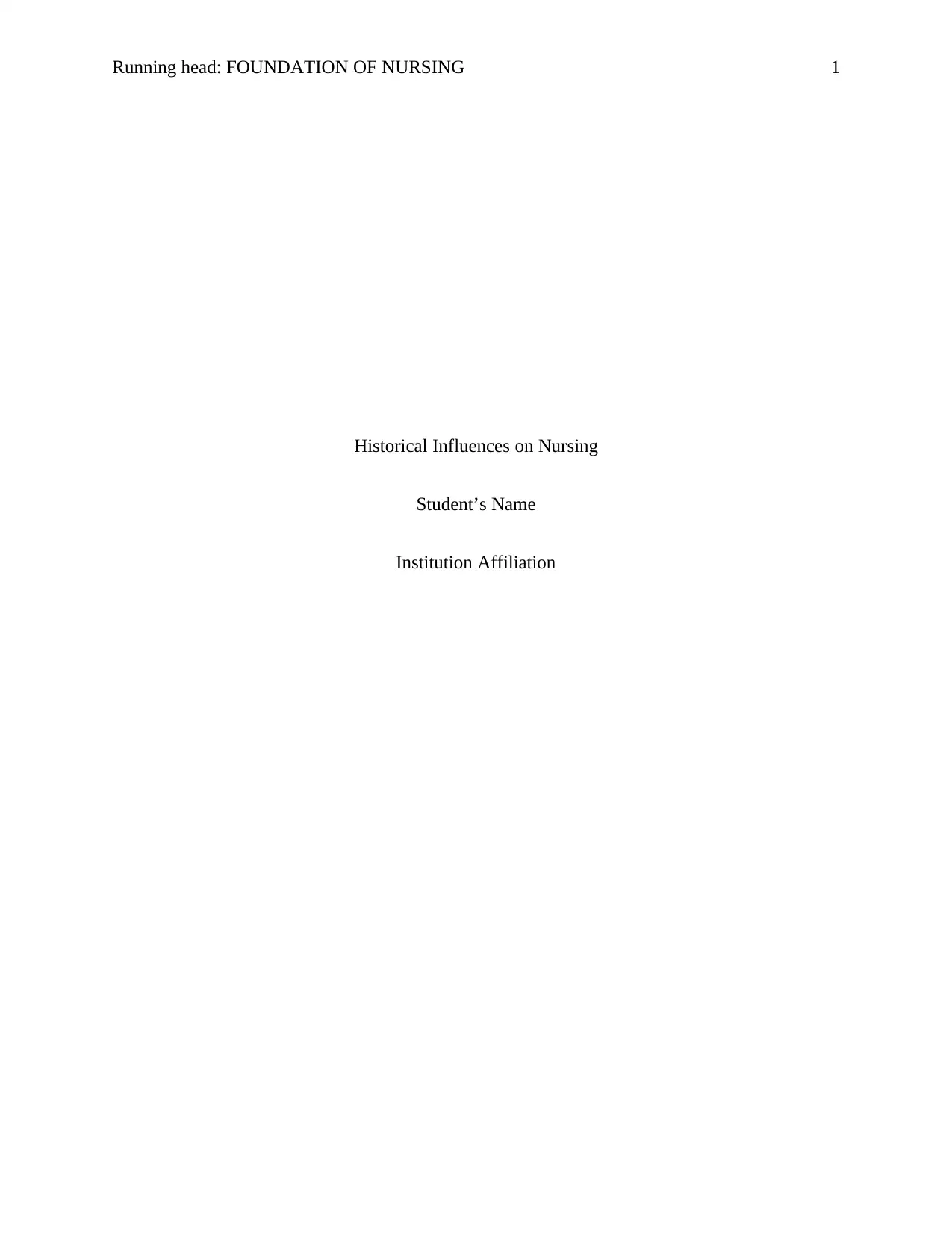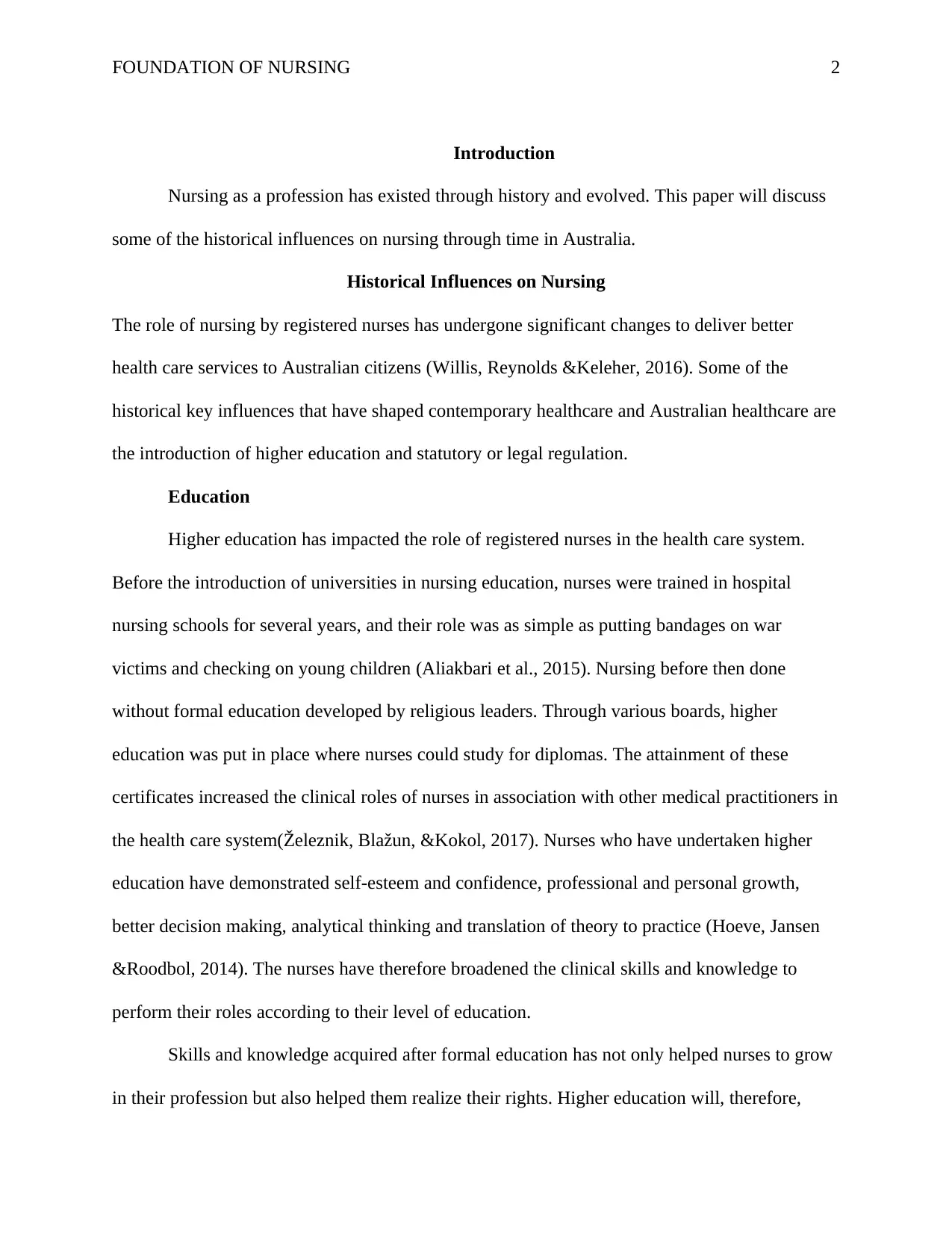Foundations of Nursing: Historical Influences on Australian Nursing
VerifiedAdded on 2023/01/18
|5
|1029
|40
Essay
AI Summary
This essay examines the historical influences on nursing in Australia, focusing on education and statutory or legal regulations. The introduction highlights the evolution of nursing and the need to understand factors shaping healthcare. The essay explores the impact of higher education on nurses' roles, skills, and confidence, emphasizing the significance of formal training. It also discusses how statutory regulations, including registration boards and health policies, have clarified nurses' roles and improved healthcare access. The essay provides examples of funding models and the increased responsibilities of registered nurses. The conclusion summarizes the changes in nursing influenced by these factors. The essay references several sources to support its arguments and provides a comprehensive overview of historical influences on Australian nursing.

Running head: FOUNDATION OF NURSING 1
Historical Influences on Nursing
Student’s Name
Institution Affiliation
Historical Influences on Nursing
Student’s Name
Institution Affiliation
Paraphrase This Document
Need a fresh take? Get an instant paraphrase of this document with our AI Paraphraser

FOUNDATION OF NURSING 2
Introduction
Nursing as a profession has existed through history and evolved. This paper will discuss
some of the historical influences on nursing through time in Australia.
Historical Influences on Nursing
The role of nursing by registered nurses has undergone significant changes to deliver better
health care services to Australian citizens (Willis, Reynolds &Keleher, 2016). Some of the
historical key influences that have shaped contemporary healthcare and Australian healthcare are
the introduction of higher education and statutory or legal regulation.
Education
Higher education has impacted the role of registered nurses in the health care system.
Before the introduction of universities in nursing education, nurses were trained in hospital
nursing schools for several years, and their role was as simple as putting bandages on war
victims and checking on young children (Aliakbari et al., 2015). Nursing before then done
without formal education developed by religious leaders. Through various boards, higher
education was put in place where nurses could study for diplomas. The attainment of these
certificates increased the clinical roles of nurses in association with other medical practitioners in
the health care system(Železnik, Blažun, &Kokol, 2017). Nurses who have undertaken higher
education have demonstrated self-esteem and confidence, professional and personal growth,
better decision making, analytical thinking and translation of theory to practice (Hoeve, Jansen
&Roodbol, 2014). The nurses have therefore broadened the clinical skills and knowledge to
perform their roles according to their level of education.
Skills and knowledge acquired after formal education has not only helped nurses to grow
in their profession but also helped them realize their rights. Higher education will, therefore,
Introduction
Nursing as a profession has existed through history and evolved. This paper will discuss
some of the historical influences on nursing through time in Australia.
Historical Influences on Nursing
The role of nursing by registered nurses has undergone significant changes to deliver better
health care services to Australian citizens (Willis, Reynolds &Keleher, 2016). Some of the
historical key influences that have shaped contemporary healthcare and Australian healthcare are
the introduction of higher education and statutory or legal regulation.
Education
Higher education has impacted the role of registered nurses in the health care system.
Before the introduction of universities in nursing education, nurses were trained in hospital
nursing schools for several years, and their role was as simple as putting bandages on war
victims and checking on young children (Aliakbari et al., 2015). Nursing before then done
without formal education developed by religious leaders. Through various boards, higher
education was put in place where nurses could study for diplomas. The attainment of these
certificates increased the clinical roles of nurses in association with other medical practitioners in
the health care system(Železnik, Blažun, &Kokol, 2017). Nurses who have undertaken higher
education have demonstrated self-esteem and confidence, professional and personal growth,
better decision making, analytical thinking and translation of theory to practice (Hoeve, Jansen
&Roodbol, 2014). The nurses have therefore broadened the clinical skills and knowledge to
perform their roles according to their level of education.
Skills and knowledge acquired after formal education has not only helped nurses to grow
in their profession but also helped them realize their rights. Higher education will, therefore,

FOUNDATION OF NURSING 3
continue empowering nurses and hence give them the confidence to efficiently conduct their
roles to the citizens of Australia in the various fields of nursing.
Statutory or legal regulation
Statutory regulation has led to a better understanding and clarification of the roles of nurses
when delivering health services (Johnstone, 2016). The primary role of nurses was not known.
Regulation boards were introduced to give clear roles of nurses. The boards have also evolved to
provide registration of nurses and regulate different types of nurses who are under various fields.
For one to be a nurse in Australia, few requirements must be met such as English skills and
criminal history check among others (Aliakbari et al., 2015). Introduction of health policies as a
regulation in nursing has also led to a significant increase in the number of employed nurses. The
ratio of general practitioners to registered nurses increased and so did the roles of nurses under
these practitioners (Železnik, Blažun, &Kokol, 2017). The increase in the number of employed
nurses led to an increase in patient to nurse ratio. The health care services are hence better
accessed by patients. Funding models for nurses were developed through time under legal
regulation to provide financial incentives to nurses. These incentives are meant to provide
evidence-based care practice for various disease groups and are led by nurses. The funds give
direct support to cater for finances while undertaking a project (Bradford, Caffery, & Smith,
2016).
The registered nurses are nowadays responsible and accountable for their practices and
provide care on their own unlike earlier in history where other health practitioners were
responsible for the action of nurses (Johnstone, 2016). The regulated nurses have more defined
roles which have enabled them to provide the primary health care services more efficiently.
Nurses who have acquired the level and type of education needed and are also registered can be
continue empowering nurses and hence give them the confidence to efficiently conduct their
roles to the citizens of Australia in the various fields of nursing.
Statutory or legal regulation
Statutory regulation has led to a better understanding and clarification of the roles of nurses
when delivering health services (Johnstone, 2016). The primary role of nurses was not known.
Regulation boards were introduced to give clear roles of nurses. The boards have also evolved to
provide registration of nurses and regulate different types of nurses who are under various fields.
For one to be a nurse in Australia, few requirements must be met such as English skills and
criminal history check among others (Aliakbari et al., 2015). Introduction of health policies as a
regulation in nursing has also led to a significant increase in the number of employed nurses. The
ratio of general practitioners to registered nurses increased and so did the roles of nurses under
these practitioners (Železnik, Blažun, &Kokol, 2017). The increase in the number of employed
nurses led to an increase in patient to nurse ratio. The health care services are hence better
accessed by patients. Funding models for nurses were developed through time under legal
regulation to provide financial incentives to nurses. These incentives are meant to provide
evidence-based care practice for various disease groups and are led by nurses. The funds give
direct support to cater for finances while undertaking a project (Bradford, Caffery, & Smith,
2016).
The registered nurses are nowadays responsible and accountable for their practices and
provide care on their own unlike earlier in history where other health practitioners were
responsible for the action of nurses (Johnstone, 2016). The regulated nurses have more defined
roles which have enabled them to provide the primary health care services more efficiently.
Nurses who have acquired the level and type of education needed and are also registered can be
⊘ This is a preview!⊘
Do you want full access?
Subscribe today to unlock all pages.

Trusted by 1+ million students worldwide

FOUNDATION OF NURSING 4
funded to study cases of various diseases such as infectious diseases, and this will enable nurses
to perform their role as health practitioners. Under policy regulations, the number of employed
nurses in the Australian general practices was low before policy introduction, and an increase in
nurses will help them perform their roles more efficiently since their concentration will increase
on each patient assigned.
Conclusion
In conclusion, the nursing profession has undergone changes in history influenced by
factors such as higher education system and changes in legal or statutory regulations.
funded to study cases of various diseases such as infectious diseases, and this will enable nurses
to perform their role as health practitioners. Under policy regulations, the number of employed
nurses in the Australian general practices was low before policy introduction, and an increase in
nurses will help them perform their roles more efficiently since their concentration will increase
on each patient assigned.
Conclusion
In conclusion, the nursing profession has undergone changes in history influenced by
factors such as higher education system and changes in legal or statutory regulations.
Paraphrase This Document
Need a fresh take? Get an instant paraphrase of this document with our AI Paraphraser

FOUNDATION OF NURSING 5
References
Aliakbari, F., Parvin, N., Heidari, M., &Haghani, F. (2015).Learning theories application in
nursing education. Journal of Education and Health Promotion, 4.doi: 10.4103/2277-
9531.151867
Bradford, N. K., Caffery, L. J., & Smith, A. C. (2016).Telehealth services in rural and remote
Australia: a systematic review of models of care and factors influencing success and
sustainability. Rural and remote health, 16(4), 3808.http://www.rrh.org.au/
Hoeve, Y. T., Jansen, G., &Roodbol, P. (2014). The nursing profession: public image, self‐
concept and professional identity. A discussion paper. Journal of Advanced Nursing,
70(2), 295-309.https://doi.org/10.1111/jan.12177
Johnstone, M. J. (2016). Key milestones in the operationalisation of professional nursing ethics
in Australia: a brief historical overview. Australian Journal of Advanced Nursing,
The, 33(4), 35.http://dro.deakin.edu.au/view/DU:30085644
Willis, E., Reynolds, L., &Keleher, H. (Eds.). (2016). Understanding the Australian health care
system. Elsevier Health Sciences.https://www.elsevier.com/books/understanding-the-
australian-health-care-system/willis/978-0-7295-4232-6
Železnik, D., BlažunVošner, H., &Kokol, P. (2017).A bibliometric analysis of the Journal of
Advanced Nursing, 1976–2015.Journal of advanced nursing, 73(10), 2407-
2419.https://doi.org/10.1111/jan.13296
References
Aliakbari, F., Parvin, N., Heidari, M., &Haghani, F. (2015).Learning theories application in
nursing education. Journal of Education and Health Promotion, 4.doi: 10.4103/2277-
9531.151867
Bradford, N. K., Caffery, L. J., & Smith, A. C. (2016).Telehealth services in rural and remote
Australia: a systematic review of models of care and factors influencing success and
sustainability. Rural and remote health, 16(4), 3808.http://www.rrh.org.au/
Hoeve, Y. T., Jansen, G., &Roodbol, P. (2014). The nursing profession: public image, self‐
concept and professional identity. A discussion paper. Journal of Advanced Nursing,
70(2), 295-309.https://doi.org/10.1111/jan.12177
Johnstone, M. J. (2016). Key milestones in the operationalisation of professional nursing ethics
in Australia: a brief historical overview. Australian Journal of Advanced Nursing,
The, 33(4), 35.http://dro.deakin.edu.au/view/DU:30085644
Willis, E., Reynolds, L., &Keleher, H. (Eds.). (2016). Understanding the Australian health care
system. Elsevier Health Sciences.https://www.elsevier.com/books/understanding-the-
australian-health-care-system/willis/978-0-7295-4232-6
Železnik, D., BlažunVošner, H., &Kokol, P. (2017).A bibliometric analysis of the Journal of
Advanced Nursing, 1976–2015.Journal of advanced nursing, 73(10), 2407-
2419.https://doi.org/10.1111/jan.13296
1 out of 5
Related Documents
Your All-in-One AI-Powered Toolkit for Academic Success.
+13062052269
info@desklib.com
Available 24*7 on WhatsApp / Email
![[object Object]](/_next/static/media/star-bottom.7253800d.svg)
Unlock your academic potential
Copyright © 2020–2025 A2Z Services. All Rights Reserved. Developed and managed by ZUCOL.





